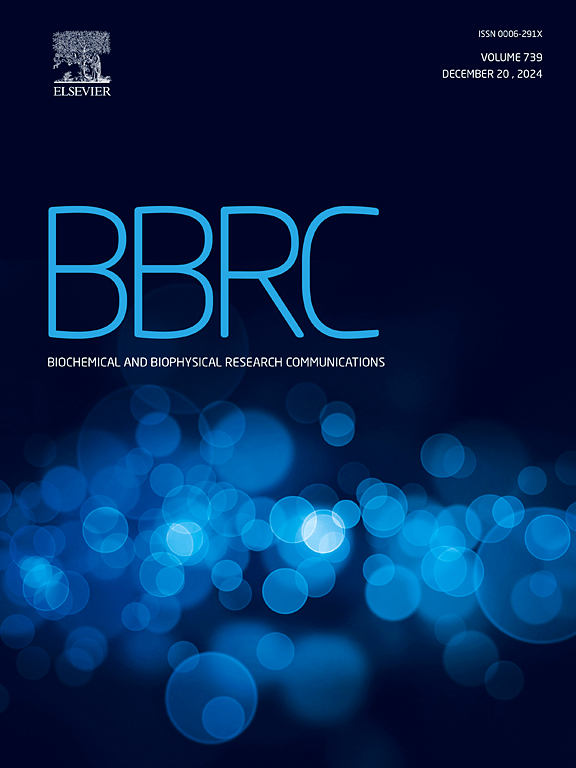Hyaluronic acid-functionalized PLGA nanoparticles loaded with circSNX6 siRNA overcome sunitinib resistance in renal cell carcinoma
IF 2.5
3区 生物学
Q3 BIOCHEMISTRY & MOLECULAR BIOLOGY
Biochemical and biophysical research communications
Pub Date : 2025-06-17
DOI:10.1016/j.bbrc.2025.152226
引用次数: 0
Abstract
Addressing the challenge of sunitinib resistance in renal cell carcinoma (RCC), while multiple molecular targets have been identified to enhance RCC's response to sunitinib, effective therapeutic strategies remain largely unidentified. Previous studies have highlighted those elevated levels of circular RNA circSNX6, a key regulator of circSNX6/miR-1184/GPCPD1 axis had a critical role in regulation of intracellular lysophosphatidic acid (LPA) levels and sunitinib resistance in RCC. Therefore, there is an urgent need for innovative treatment strategies to combat sunitinib resistance. In this study, we developed hyaluronic acid-modified poly (lactic-co-glycolic acid) nanoparticles (HA-PLGA-NPs) loaded with circSNX6 small interfering RNA (siRNA), designed as a targeted delivery system to overcome drug resistance in RCC. Compared to CD44-negative cells, HA-PLGA-NPs demonstrated markedly improved binding affinity to CD44-positive RCC cells, thereby enhancing their sensitivity to sunitinib. RNA sequencing (RNA-seq) data revealed that circSNX6 knockdown promoted apoptosis, induced mitochondrial changes, and negatively regulated the organization of mitochondrion. In an RCC xenograft model with established sunitinib resistance, the injection of HA-PLGA-NPs carrying circSNX6 siRNA effectively reversed this resistance. These results reveal a novel molecular mechanism through which circSNX6 mediates sunitinib resistance in RCC, and suggest that HA-PLGA-NPs could represent a promising and selective approach for overcoming this resistance.
负载circSNX6 siRNA的透明质酸功能化PLGA纳米颗粒克服了肾细胞癌中舒尼替尼的耐药
针对肾细胞癌(RCC)中舒尼替尼耐药的挑战,虽然已经确定了多个分子靶点来增强RCC对舒尼替尼的反应,但有效的治疗策略仍未确定。先前的研究强调了环状RNA circSNX6水平的升高,circSNX6/miR-1184/GPCPD1轴的关键调节因子在RCC细胞内溶血磷脂酸(LPA)水平和舒尼替尼耐药性的调节中起关键作用。因此,迫切需要创新的治疗策略来对抗舒尼替尼耐药性。在这项研究中,我们开发了透明质酸修饰的聚(乳酸-羟基乙酸)纳米颗粒(HA-PLGA-NPs),负载circSNX6小干扰RNA (siRNA),设计为一种靶向递送系统,以克服RCC的耐药。与cd44阴性细胞相比,HA-PLGA-NPs与cd44阳性RCC细胞的结合亲和力显著提高,从而增强了它们对舒尼替尼的敏感性。RNA测序(RNA-seq)数据显示,circSNX6敲低促进细胞凋亡,诱导线粒体改变,负向调节线粒体的组织。在具有舒尼替尼耐药的RCC异种移植模型中,注射携带circSNX6 siRNA的HA-PLGA-NPs有效地逆转了这种耐药。这些结果揭示了circSNX6介导RCC舒尼替尼耐药的一种新的分子机制,并表明HA-PLGA-NPs可能是克服这种耐药的一种有前途的选择性方法。
本文章由计算机程序翻译,如有差异,请以英文原文为准。
求助全文
约1分钟内获得全文
求助全文
来源期刊
CiteScore
6.10
自引率
0.00%
发文量
1400
审稿时长
14 days
期刊介绍:
Biochemical and Biophysical Research Communications is the premier international journal devoted to the very rapid dissemination of timely and significant experimental results in diverse fields of biological research. The development of the "Breakthroughs and Views" section brings the minireview format to the journal, and issues often contain collections of special interest manuscripts. BBRC is published weekly (52 issues/year).Research Areas now include: Biochemistry; biophysics; cell biology; developmental biology; immunology
; molecular biology; neurobiology; plant biology and proteomics

 求助内容:
求助内容: 应助结果提醒方式:
应助结果提醒方式:


